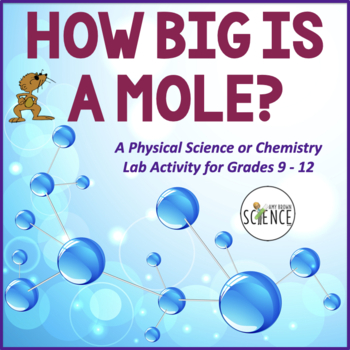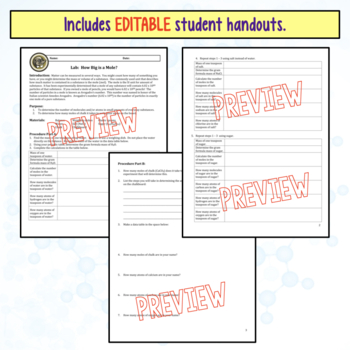Lab: How Big is a Mole? Introduction to the Mole Concept
- Zip
What educators are saying
Description
You know that confused look we see when we first introduce the idea of "moles" to our physical science or chemistry students? This lab will help erase that look from their faces. Students often have a difficult time grasping the concept of the mole. They need multiple opportunities to see the size of a mole, and they need to practice converting between the units of moles, mass, and molecules.
I love the simplicity of this lab activity. Students will find the mass of one teaspoon of a common substance (water, salt, sugar), and use the mass to determine the number of moles and and molecules in the teaspoon of substance.
In the second part of the lab, students will design an experiment to determine the number of moles of chalk it takes to write their name on a chalkboard. They will describe their procedure, construct a data table, and use their data to determine the number of moles of chalk in their name.
Suitable for Physical Science or Chemistry Students in Grades 9-12
Purpose of the Lab:
- To determine the number of molecules and/or atoms in small amounts of everyday substances.
- To determine how many moles of chalk it takes to write your name on the board.
Simple Materials List:
Balance, water, salt, sugar, plastic spoon, chalk, chalkboard.
This activity is quick and easy to set up. Just print the students pages, place items at lab stations, and you are ready for a great practice and review activity.
Complete Teacher Guide and Answer Key Included.
Related products include:
- Mole Conversions (Mass / Moles / Molecules) Practice Worksheet 1
- Mole Conversions (Mass / Moles / Molecules) Practice Worksheet 2
- Mole Conversions (Mass / Moles / Molecules) Practice Worksheet 3
- Mole Conversions (Mass / Moles / Molecules) Practice Worksheet 4
- Molar Volume of Gases Conversion Problems (Moles, Mass, Molecules, Volume)
- Lab: Percent Composition
- Spring Theme Hidden Picture- The Mole Concept and Stoichiometry Review Questions
- Lab: Mole and Mass Relationships
- Lab: Understanding the Mole concept
- Moles Mass Molecules Conversions Worksheet Bundle
- Lab: Composition of a Hydrate
For updates about sales and new products, please follow my store:




